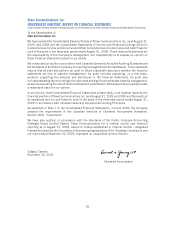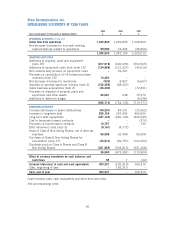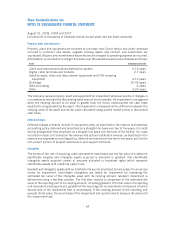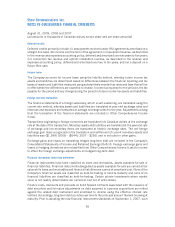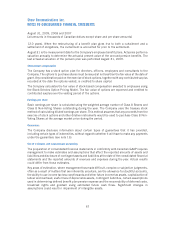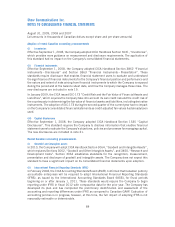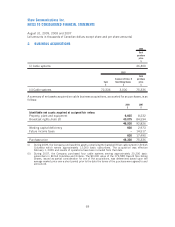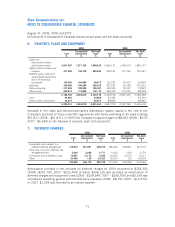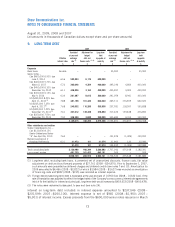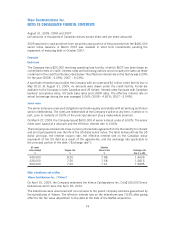Shaw 2009 Annual Report Download - page 69
Download and view the complete annual report
Please find page 69 of the 2009 Shaw annual report below. You can navigate through the pages in the report by either clicking on the pages listed below, or by using the keyword search tool below to find specific information within the annual report.Deferred credits
Deferred credits primarily include: (i) prepayments received under IRU agreements amortized on a
straight-line basis into income over the term of the agreement; (ii) equipment revenue, as described
in the revenue and expenses accounting policy, deferred and amortized over two years to five years;
(iii) connection fee revenue and upfront installation revenue, as described in the revenue and
expenses accounting policy, deferred and amortized over two to ten years; and (iv) a deposit on a
future fibre sale.
Income taxes
The Company accounts for income taxes using the liability method, whereby future income tax
assets and liabilities are determined based on differences between the financial reporting and tax
bases of assets and liabilities measured using substantively enacted tax rates and laws that will be
in effect when the differences are expected to reverse. Income tax expense for the period is the tax
payable for the period and any change during the period in future income tax assets and liabilities.
Foreign currency translation
The financial statements of a foreign subsidiary, which is self-sustaining, are translated using the
current rate method, whereby assets and liabilities are translated at year-end exchange rates and
revenues and expenses are translated at average exchange rates for the year. Adjustments arising
from the translation of the financial statements are included in Other Comprehensive Income
(Loss).
Transactions originating in foreign currencies are translated into Canadian dollars at the exchange
rate at the date of the transaction. Monetary assets and liabilities are translated at the year-end rate
of exchange and non-monetary items are translated at historic exchange rates. The net foreign
exchange gain (loss) recognized on the translation and settlement of current monetary assets and
liabilities was ($1,599) (2008 – ($644); 2007 – $255) and is included in other gains.
Exchange gains and losses on translating hedged long-term debt are included in the Company’s
Consolidated Statements of Income and Retained Earnings (Deficit). Foreign exchange gains and
losses on hedging derivatives are reclassified from Other Comprehensive Income (Loss) to income
to offset the foreign exchange adjustments on hedged long-term debt.
Financial instruments other than derivatives
Financial instruments have been classified as loans and receivables, assets available-for-sale or
financial liabilities. Financial instruments designated as assets available-for-sale are carried at fair
value while loans and receivables and financial liabilities are carried at amortized cost. None of the
Company’s financial assets are classified as held-for-trading or held-to-maturity and none of its
financial liabilities are classified as held-for-trading. Certain private investments where market
value is not readily determinable are carried at cost net of write-downs.
Finance costs, discounts and proceeds on bond forward contracts associated with the issuance of
debt securities and fair value adjustments on debt assumed in business acquisitions are netted
against the related debt instrument and amortized to income using the effective interest rate
method. Accordingly, long-term debt accretes over time to the principal amount that will be owing at
maturity. Prior to adopting the new financial instruments standards on September 1, 2007, such
65
Shaw Communications Inc.
NOTES TO CONSOLIDATED FINANCIAL STATEMENTS
August 31, 2009, 2008 and 2007
[all amounts in thousands of Canadian dollars except share and per share amounts]


